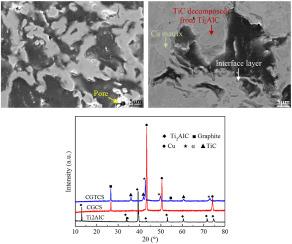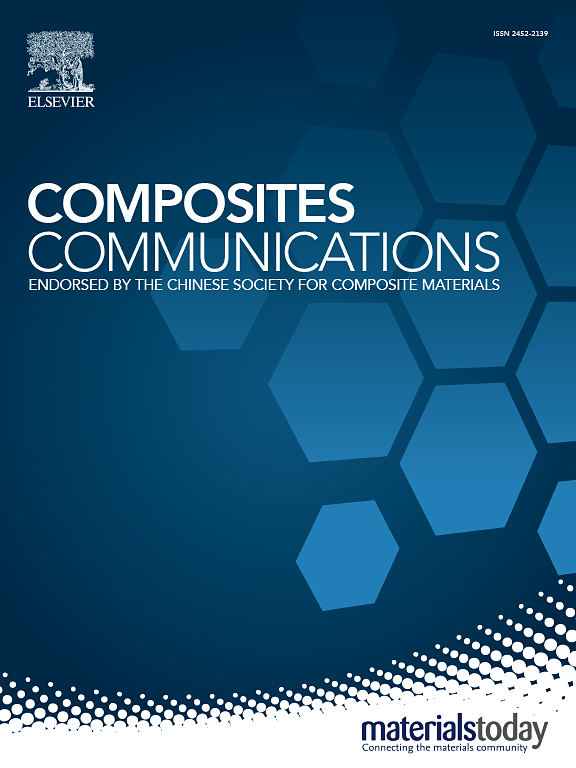Effect of Ti2AlC on the microstructure and properties of Cu-graphite composites
IF 6.5
2区 材料科学
Q1 MATERIALS SCIENCE, COMPOSITES
引用次数: 0
Abstract
Cu-graphite composites (CGCS) find extensive applications in electrical contact components. However, due to insufficient wetting between Cu and graphite, their bonding remains weak. Additionally, the Cu coating on the surface of graphite in Cu-coated graphite particles used to fabricate CGCS tends to segregate during sintering, which leads to defects such as porosity. To address these issues, this study incorporated Ti2AlC into CGCS sintered at 980 °C using a pneumatic sintering process. Subsequently, the microstructure and properties of the composites were examined and analyzed. The findings indicated that incorporating Ti2AlC prevented severe segregation of the Cu coating on the graphite surface during sintering, maintaining complete coverage of the graphite particles by the Cu matrix. In addition, the development of a TiC layer increased the interface bonding strength between the Cu matrix and graphite from 0.40 GPa to 5.00 GPa. Besides, CGCS with Ti2AlC exhibits better mechanical properties and tribological properties; their hardness, compressive strength, and wear rate are 64.5 HV, 269 MPa, 1.378×10−5 mm3/N·m, respectively.

Ti2AlC 对铜-石墨复合材料微观结构和性能的影响
铜石墨复合材料(CGCS)在电接触元件中应用广泛。然而,由于铜和石墨之间的润湿性不足,它们的结合力仍然很弱。此外,用于制造 CGCS 的铜涂层石墨颗粒中石墨表面的铜涂层在烧结过程中容易发生偏析,从而导致气孔等缺陷。为了解决这些问题,本研究在使用气动烧结工艺于 980 °C 烧结的 CGCS 中加入了 Ti2AlC。随后,对复合材料的微观结构和性能进行了研究和分析。研究结果表明,Ti2AlC 的加入防止了烧结过程中石墨表面铜涂层的严重偏析,保持了铜基体对石墨颗粒的完全覆盖。此外,TiC 层的形成将铜基体与石墨之间的界面结合强度从 0.40 GPa 提高到 5.00 GPa。此外,含有 Ti2AlC 的 CGCS 还具有更好的机械性能和摩擦学性能;其硬度、抗压强度和磨损率分别为 64.5 HV、269 MPa 和 1.378×10-5 mm3/N-m。
本文章由计算机程序翻译,如有差异,请以英文原文为准。
求助全文
约1分钟内获得全文
求助全文
来源期刊

Composites Communications
Materials Science-Ceramics and Composites
CiteScore
12.10
自引率
10.00%
发文量
340
审稿时长
36 days
期刊介绍:
Composites Communications (Compos. Commun.) is a peer-reviewed journal publishing short communications and letters on the latest advances in composites science and technology. With a rapid review and publication process, its goal is to disseminate new knowledge promptly within the composites community. The journal welcomes manuscripts presenting creative concepts and new findings in design, state-of-the-art approaches in processing, synthesis, characterization, and mechanics modeling. In addition to traditional fiber-/particulate-reinforced engineering composites, it encourages submissions on composites with exceptional physical, mechanical, and fracture properties, as well as those with unique functions and significant application potential. This includes biomimetic and bio-inspired composites for biomedical applications, functional nano-composites for thermal management and energy applications, and composites designed for extreme service environments.
 求助内容:
求助内容: 应助结果提醒方式:
应助结果提醒方式:


